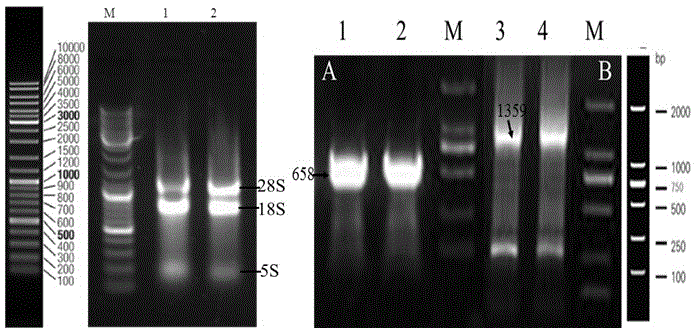Recombinant gene of glutamate dehydrogenase, acquisition method of recombinant gene, and application of glutamate dehydrogenase recombinant enzyme
A technology of glutamate dehydrogenase and recombinant gene, which is applied in the field of recombinant gene of glutamate dehydrogenase and its acquisition, can solve the problems of unsuitability for industrial production, low enzyme yield, and long time consumption, and achieve low production cost , High degradation efficiency, high safety effect
- Summary
- Abstract
- Description
- Claims
- Application Information
AI Technical Summary
Problems solved by technology
Method used
Image
Examples
Embodiment 1
[0108] Step 1: Preparation of bacteria:
[0109] The Geotrichum candidum CCTCC NO:M 208167 strain was inoculated into potato juice glucose liquid medium (1000 mL of 20% potato juice, 20 g glucose, natural pH), and cultured at 28°C and 160 rpm for 18 hours, at 2.0% The inoculum amount is connected to the above medium to expand the culture, the conditions are the same, the culture time is 38h, the resulting culture is centrifuged at 5000rpm, 4℃ for 10min, the bacteria are collected, resuspended and centrifuged with sterile water, repeated 5 times, and finally Centrifuge at 8000 rpm and 4°C for 10 min to collect the wet bacteria. After induction treatment with MSM medium at 28°C and 160 rpm for 6 hours, centrifuge at 5000 rpm and 4°C for 10 minutes to collect the bacteria and wash it with sterile water 5 times. 8 000 r / m, centrifugation at 4 ℃ for 10 min, collect bacteria to extract total RNA.
[0110] Step 2: Extraction of total bacterial RNA:
[0111] The method for extracting total...
Embodiment 2
[0114] Step 1: Preparation of bacteria:
[0115] The same as in Example 1.
[0116] Step 2: Cloning of conserved regions and full-length sequences:
[0117] ①Conserved region amplification primers:
[0118] GDH-F1 5'- GGATC CACGCCGCTCAAGGTC-3' BamHⅠ
[0119] GDH-R1 5'- AAGCTT TACCAAGAAATCACCGTGGTC-3' HindⅢ
[0120] Full-length sequence amplification primers:
[0121] GDH-F2 5'-CG GGATCC ATCAAAATGGTCCAGCCTTCC-3' BamHⅠ
[0122] GDH-R2 5'-CCC AAGCTT TTACCAGAAATCACCGTGGTCG-3' HindⅢ
[0123] ②Conserved region and full-length sequence of glutamate dehydrogenase gene PCR amplification system
[0124]
[0125] ③PCR reaction conditions
[0126] Reaction conditions in the conservative zone: pre-denaturation 95 ℃, 5 min; denaturation temperature 94 ℃, 30 s; annealing temperature 55.6 ℃ and 58.0 ℃, 30 s; extension temperature 72 ℃, 1:30 min; after 35 cycles, 72 ℃ Extend for 10 min.
[0127] Reaction conditions for the full-length sequence: pre-denaturation 95 ℃, 3 min; denaturation temperature 94 ℃, ...
Embodiment 3
[0131] Step 1: Preparation of bacteria:
[0132] The same as in Example 1.
[0133] Step 2: Expression of the conserved region and full-length sequence of the enzyme gene:
[0134] (1) After the PCR amplification product is recovered, it is connected to pMD19-T (pMD19-T-658-GDH (conserved region) and pMD19-T-1359-GDH (full-length sequence)) and transformed E.coli DH5α competent cells, pick the positive colonies, extract the plasmid and PCR detection, the positive clones have been sequenced. Then the recombinant T vector (pMD19-T-658-GDH (conserved region) and pMD19-T-1359-GDH (full-length sequence)) and expression vector (pET-28as) were digested with BamHI and HindⅢ.
[0135]
[0136] (2) Place the reaction at 37 ℃ overnight, perform 1% agarose gel electrophoresis, cut the gel to recover the target band, and purify it with the Omega gel recovery kit. Then the expression vector is connected, and the target fragment after restriction digestion is connected with the expression vector....
PUM
 Login to View More
Login to View More Abstract
Description
Claims
Application Information
 Login to View More
Login to View More - Generate Ideas
- Intellectual Property
- Life Sciences
- Materials
- Tech Scout
- Unparalleled Data Quality
- Higher Quality Content
- 60% Fewer Hallucinations
Browse by: Latest US Patents, China's latest patents, Technical Efficacy Thesaurus, Application Domain, Technology Topic, Popular Technical Reports.
© 2025 PatSnap. All rights reserved.Legal|Privacy policy|Modern Slavery Act Transparency Statement|Sitemap|About US| Contact US: help@patsnap.com



